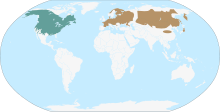
Back فأر المسك Arabic فار المسك ARZ Ondatra zibethicus AST Yendol (Ondatra zibethicus) AVK Ondatra zibethicus Azerbaijani Ондатра Bashkir Андатра Byelorussian Андатра BE-X-OLD Ондатра Bulgarian Razh-musk Breton
| Muskrat | |
|---|---|

| |
| Muskrat on the shore of Gubiščes lake in Daugavpils, Latvia | |
| Scientific classification | |
| Domain: | Eukaryota |
| Kingdom: | Animalia |
| Phylum: | Chordata |
| Class: | Mammalia |
| Order: | Rodentia |
| Family: | Cricetidae |
| Subfamily: | Arvicolinae |
| Tribe: | Ondatrini |
| Genus: | Ondatra Link, 1795 |
| Species: | O. zibethicus
|
| Binomial name | |
| Ondatra zibethicus (Linnaeus, 1766)
| |

| |
| Range of the Muskrat Native Introduced
| |
| Synonyms | |
|
Castor zibethicus Linnaeus, 1766 | |
The muskrat (Ondatra zibethicus) is a medium-sized semiaquatic rodent native to North America and an introduced species in parts of Europe, Asia, and South America. The muskrat is found in wetlands over various climates and habitats. It has crucial effects on the ecology of wetlands,[2] and is a resource of food and fur for humans.
Adult muskrats weigh 0.6–2 kg (1+1⁄4–4+1⁄2 lb), with a body length (excluding the tail) of 20–35 cm (8–14 in). They are covered with short, thick fur of medium to dark brown color. Their long tails, covered with scales rather than hair, are laterally compressed and generate a small amount of thrust, with their webbed hind feet being the main means of propulsion,[3] and the unique tail mainly important in directional stability. Muskrats spend most of their time in the water and can swim underwater for 12 to 17 minutes. They live in families of a male and female pair and their young. They build nests to protect themselves from the cold and predators, often burrowed into the bank with an underwater entrance. Muskrats feed mostly on cattail and other aquatic vegetation but also eat small animals.
Ondatra zibethicus is the only extant species in the genus Ondatra. It is the largest species in the subfamily Arvicolinae, which includes 142 other species of rodents, mostly voles and lemmings. Muskrats are referred to as "rats" in a general sense because they are medium-sized rodents with an adaptable lifestyle and an omnivorous diet. They are not, however, members of the genus Rattus. They are not closely related to beavers, with which they share habitat and general appearance.
- ^ Cassola, F. (2016). "Ondatra zibethicus". IUCN Red List of Threatened Species. 2016: e.T15324A22344525. doi:10.2305/IUCN.UK.2016-3.RLTS.T15324A22344525.en. Retrieved November 19, 2021.
- ^ Keddy, Paul A. (2010). Wetland Ecology: Principles and Conservation (2nd ed.). New York: Cambridge University Press. p. 162. ISBN 978-0-521-73967-2. LCCN 2010009142.
- ^ Fish, F.E. (1982). "Function of the Compressed Tail of Surface Swimming Muskrats (Ondatra zibethicus)". American Journal of Mammalogy. 63 (4): 591–597. doi:10.2307/1380263. JSTOR 1380263.
© MMXXIII Rich X Search. We shall prevail. All rights reserved. Rich X Search
